-
Posts
624 -
Joined
-
Last visited
Content Type
Profiles
Forums
Store
Help Articles
Posts posted by Shiewie
-
-
Good idea TP! I still have leftovers of both items at home from CNY.
-
Shiewie, is emping difficult to find in Malaysia? I was looking for it all over, and managed only to find some already fried, probably years before I bought them. They were stale and strangely flavored. ( I am almost certain they sprinkled maggi mee (instant ramen) seasoning on them ). Now I have lost all faith in Malaysian emping.
Emping is my all time favorite salty snack.... I'm so jealous.
Hmmm... we used to get our supply of emping buah belinjao / buah sakok from Kuala Terengganu (KT) market from our annual CNY visits there. They're the same as the ones from Indonesia - raw ones that you fry at home. They're easily available in the KT market and I haven't tried getting them in KL. kew - do you know if you can get them in KL?
My mum thought she had scored super-grade ones from Bali this time as they looked considerably larger than the ones we get in Terengganu ... till she fried them today and realized that they had pounded several fruit together to make each keropok
 .
. -
Some food pics from a recent trip to Bali
Ayam Bumbu Bali (chicken cooked with spices served with jackfruit and rice) at Cafe Lotus in Ubud
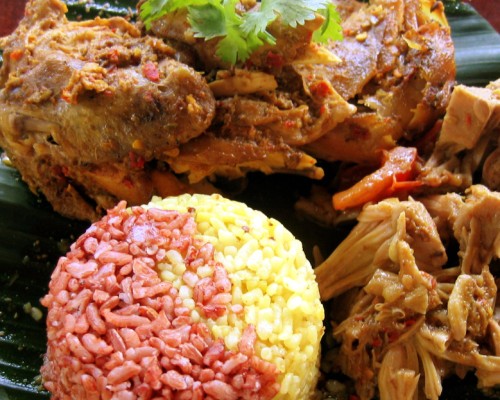
That looks beautiful! Do you know how they get the red and yellow? From commercial food coloring, or do you suppose they use ingredients like turmeric (a little darker yellow, though, I think) and tomato juice or something?
And was the food tasty?
Thanks Michael
 . The red rice is naturally so I think - my mum had a seafood fried rice with Balinese red rice at the same restaurant. The yellow is likely to be from turmeric - how yellow it gets depends on how long the raw rice is soaked with turmeric before it is cooked.
. The red rice is naturally so I think - my mum had a seafood fried rice with Balinese red rice at the same restaurant. The yellow is likely to be from turmeric - how yellow it gets depends on how long the raw rice is soaked with turmeric before it is cooked.I have to confess that I edited the photo somewhat
 - turned up the yellow tones as the dish was plated on a reddish coconut wood plate on top of a banana leaf so the original picture had a purplish hue to it.
- turned up the yellow tones as the dish was plated on a reddish coconut wood plate on top of a banana leaf so the original picture had a purplish hue to it.The food at Cafe Lotus was tasty but not particularly spicy - also tasted some chicken curry and fish curry - different from what we get in Malaysia - slightly different spice mixture and lighter (less santan). I think the heat of the dishes at Cafe Lotus there may have been toned down somewhat as the patrons were all tourists. This was definitely not the case at the Babi Guling place in Denpasar - it was all locals there and that sambal was searingly hot - couldn't finish the sambal and I didn't even touch the fried chillies served with the rice at all.
-
ozmouse, I was completely charmed by your post. I have a trip to Bali coming up soon, I hope to be as enchanted as you were.
Shiewie - recent trip to Bali & you didn't get in touch with me? Ooohh, I feel neglected

Your photos are amazing, that yin yang rice looks quite festive, I might try something like that soon.
Oh yeah, when were you here?
Ooops sorry Yetty - I swear I did think of you when we flew past Java
 - hey Java and Bali are different islands and they're big ones too - it would've been difficult to hop, skip and jump across to visit ya
- hey Java and Bali are different islands and they're big ones too - it would've been difficult to hop, skip and jump across to visit ya  . Bandung will have to be a separate visit - next time.
. Bandung will have to be a separate visit - next time.Thank you for the photo compliments
 . Didn't manage to get many pics of the other meals there as my hands are too wobbly to take close-up photos without the flash on in the evenings.
. Didn't manage to get many pics of the other meals there as my hands are too wobbly to take close-up photos without the flash on in the evenings.Anyway, these were the only 2 meals that we ate out while in Bali - we were on a family trip that one of my cousins had organized, a group of 15 with 6 kids under the age of eleven in tow, so you can imagine what an expedition it was to get everyone out of the house each time
 .
.We were there a couple of weekends ago - a 4 day visit but only 2 full days there as it was difficult to get the better-timed flights. But I managed to get some very nice emping buah belinjao (a bitterish cracker but somehow the bitterness goes quite well with the salt sprinkled on it) and vanilla beans (it's really difficult to get vanilla beans in Malaysia) from the big market in Denpasar.
Michael - you may remember emping buah belinjao as keropok buah sakok in Terengganu speak.
Yetty - when are you off to Bali?
-
Some food pics from a recent trip to Bali
Ayam Bumbu Bali (chicken cooked with spices served with jackfruit and rice) at Cafe Lotus in Ubud

Babi Guling (spit roasted pig) meal at Babi Guling Rebo on Raya Sesetan in Denpasar - a mixed plate of crackling, roast pork topped with a super spicy sambal, pork sate (it tasted more like char siu than the satay I know
 ), deep-fried pig intestines and liver, veggies (long bean leaves, finely chopped long beans, jackfruit, chopped chillies, shredded coconut and chopped boiled pork skin) served with a spicy sour soup of pork ribs and banana stem and of course rice (more fried chillies and shallots on the side if you want it spicier).
), deep-fried pig intestines and liver, veggies (long bean leaves, finely chopped long beans, jackfruit, chopped chillies, shredded coconut and chopped boiled pork skin) served with a spicy sour soup of pork ribs and banana stem and of course rice (more fried chillies and shallots on the side if you want it spicier).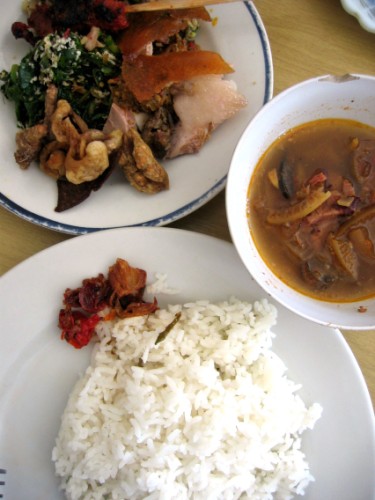
Close-up of the mixed-plate

-
Sue-On, DH has, on many occasions, seen the yau tieu guy make the one with the sticky rice middle. According to him,
- the guy takes a longish block of prepared sticky rice (I suppose it's just sticky rice steamed with salt added to it).
- he then rolls the yau tieu dough into a flat rectangle,
- wets the sticky rice on all sides,
- position the sticky rice block in the middle of the dough,
- covers the block with dough, pinching the joins
- proceeds to slice the now longish block into individual pieces.
Will post the picture later....have sent DH on his merry way to the market to get some.
I think they call those ka joong. Some yau char kwai stalls also sell ngau lei so - the ones with with the crunchy bits in the middle of two shorter yau char kwai, ma keok - the rectangle ones and of course ham jeen paeng - the round ones, either plain with a dash of 5 spice powder inside or filled with red bean paste.
My favourite yau char kwai stall downtown has all of it - will try to get pics of them soon but I'm afraid I won't be able to do it this weekend - it's F1 weekend here and traffic is going to be madness in town.
-
I was going to suggest a cake shaped like a white peach but Shiewie beat me to it!
It's the time difference
 !
! -
Here are a couple of ideas from an aunt's 89th birthday - in fondant so it's the kind of thing you do (like kew says
 ).
).This was the centrepiece on each table - old man "Sau" (longevity) from Fook Luk Sau sitting under a peach tree
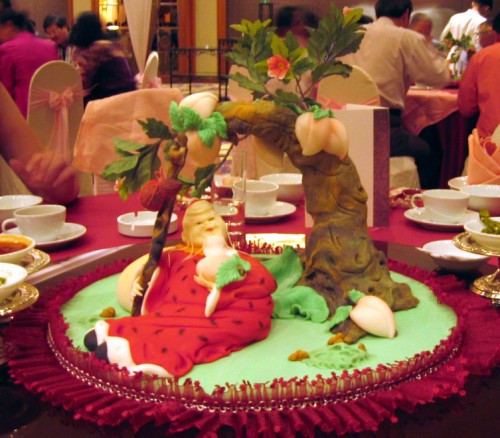
- The same "sau tho" (longevity peach) theme was repeated on the cake that was shaped as a giant peach with a peach tree on top of it
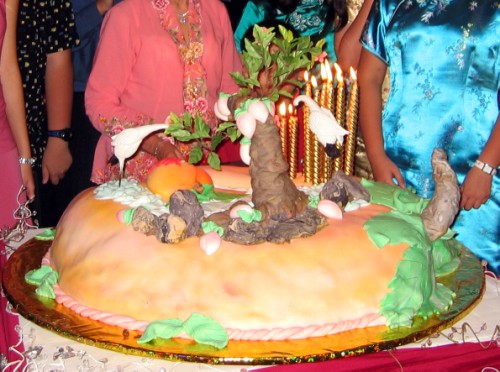
-
Shiewie, that bowl of laksa looks like it's from a bistro in Plaza Mont Kiara... right?
Yup, that's right.
-
Not sure what kind of influence it is but it's quite common to dip yau char kwai in hot local sweet black coffee in Malaysia and Singapore. Probably a case of what's available.
The local coffee here is somewhat similar to Vietnamese coffee and is roasted in butter. It's brewed differently though - ground coffee is place in a cloth bag attached to a metal handle and ladels of hot water is poured onto the gounf coffee in the cloth bags.
-
Pumpkin kaya recipe (an example of a deceptively simple recipe)

One pumpkin slightly smaller than a soccer ball
6 medium-sized eggs
3 pcs pandan leaves (cut into 2-inch lengths)
first pressed milk from one coconut (approx. 200 ml)
150 ml gran. sugar
pinch of salt
Decapitate soccer ball pumpkin. Remove seeds and stringy stuff. Wash, dry.
Beat sugar together with eggs and pandan leaves till sugar has dissolved. Remove leaves. Stir in coconut milk (with salt added to it earlier).
Set the pumpkin in a heat-proof bowl. Pour mixture into cavity. Steam for an hour or so. Test with fork to see if the custard has set. This baby takes a looooong time to cool down. Give it some help. It tastes very good when chilled.
Ooh - this is clever - using the pumpkin in its skin as a pie shell.
Question - you beat the 2-inch length of pandan leaves with the eggs? Guess it won't look so pretty if the custard were green with pandan juice? Am planning to try this - it sure would make quite a pretty presentation at the table.
-
... she rewarded my family with a delicious cheese tart. No touching, please...that's MINE.
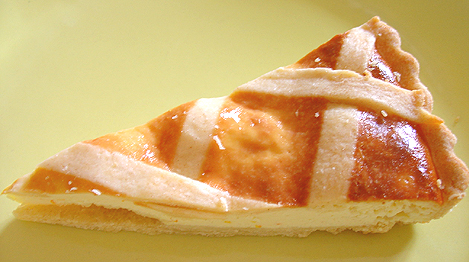
Please oh please can I have a piece if I drive over to your place right now
 ?.. where I got the coconut for tonite's dessert.
?.. where I got the coconut for tonite's dessert.You had coconut with the cheese tart?
Where is this new cake supplies shop?
-
it's main efficacy is to clear the women's system
So it's not one of those "warming" things???
It's supposed to help your blood circulation, regulate ... thought I'd try to explain it but this site does a much better job on the benefits of dong guai and dong sum
Big pat for TP for boiling yeok choy tong (herbal soup) for lunch.
-
-
Kew/ Yetty - any other ways which cempedak is eaten? Curries
 ?
?My Grandma used to make cempedak jam, but then she turned all fruits into jam. I miss rambutan jam, durian jam and mangosteen jam. (My Grandpa had an orchard)
I can imagine cempedak jam and durian jam ... would they be sort of pengat (a sweet durian porridge with coconut milk) like, brown and gluggy (hmm doesn't sound like too appetising a description eh
 )?
)?But what would rambutan jam and mangosteeen jam be like? Is it delicate and translucent like the flesh of fruit or does cooking it change it somewhat?
-
Was a good girl today. So I made "soup for girls". In the soup is a Spring Chicken, fresh shiitake mushrooms, Dong Gui (angelica sinensis), Dong Sum (codonopsis pilosula), Gei Zi (wolfberry/boxthorn berry/lycium barbarum), Red Dates. Added mee sua and cos lettuce to make up lunch.[...]
That looks like a soup I'd like. So why is it "soup for girls"? Just because you made it for them, or are some of the ingredients supposed to be particularly good for girls' health?
Dong guai (cantonese)/ dang gui (mandarin) and dong sum (Cantonese)/ dang shen (Mandarin) are herbs that are good for women so I guess that's why TP called it "soup for girls".
helenjp - you can also add in some dried scallops (conpoy / gawn yue chue) and dried longans for a "sweeter" soup.
-
Yup, they look like cempedak - a cousin of nangka (jackfruit) but not sure what they're called in English. Cempedaks are more intense smelling than jackfruits while the flesh is mushier than that of jackfruit, it's lcreamy but with bits of fibre in it. You can either eat it fresh or dipped in batter and fried like banana fritters.
Kew/ Yetty - any other ways which cempedak is eaten? Curries
 ?
?There are big seeds in them, like nangka seeds and these too can be eaten if you boil them.
I don't think there's any special English name for cempedak, which I figure those in the know consider to be just a particular variety of jackfruit. And I'd use the word "stinky" rather than the more decorous "more intense smelling."



I'll have a taste of cempedak, durian or nangka when there's some around but I'm not a fan of any of them. So, by all means call all or any of them stinky. My grandfather who didn't like durian either used to equate its smell to cat poo

 .
.Hey Laksa does this qualify as weirdness, a Malaysian of doesn't like durian ?!! I don't like chocolate either.
-
Oh. My. God. Kew,Tepee & Shiewie!!!
Tears of joy are just rolling down my cheeks, I'm so enraptured with this blog! I can relate to most everything here. If I don't get a chance to later, let me thank you now for a most enjoyable virtual trip to Malaysia. I hope to take a real one soon.
You're welcome, and thank you for joining us in this blog.

I sure hope to meet you when you visit. Do plan a stopover in Putrajaya.
Yes Yetty, do come visit.
I love reading about posts on Bandung too - similarly, I relate to a lot that you post too. Bandung sounds like a really nice place - just finished reading a book about a boy who spent his childhood on a tea plantation in the hills of Bandung.
-
TP, what are those brown fruits, in front of the boxes of mandarins, and behind the pineapples?
Can't see quite clearly but maybe they're cempedaks?

Yup, they look like cempedak - a cousin of nangka (jackfruit) but not sure what they're called in English. Cempedaks are more intense smelling than jackfruits while the flesh is mushier than that of jackfruit, it's creamy but with bits of fibre in it. You can either eat it fresh or dipped in batter and fried like banana fritters.
Kew/ Yetty - any other ways which cempedak is eaten? Curries
 ?
?There are big seeds in them, like nangka seeds and these too can be eaten if you boil them.
-
Did you make the kuih kapit (love letters)? Strangely, I like soft kuih kapit that's been left out for too long as much as the fresh crispy ones - it's fun to try and slowly unfold them
 .
.Yeah, that's very strange, Shiewie. What else do you do that's strange?

Lots and too embarassing to name them all here

 .
. -
SHIEWIE!!!!!! Come back! I need you to identify some veggies in english. (I haven't lived abroad before, so I'm afraid my food terms are pretty much confined to M'sian names).
Saved by kew
 .
. -
So does anyone know if kueh kapit has its origins in Kapit, Sarawak?
I have no idea
 As far as I remember it, my Grandma made them herself after being taught by my Chinese grandfather. They are such a pain to make. And the mold was rather heavy too.
As far as I remember it, my Grandma made them herself after being taught by my Chinese grandfather. They are such a pain to make. And the mold was rather heavy too. At that time, Kuih Kapit was very much a Chinese kuih. Nowadays, they are probably considered as a Malay kuih as well. I sure see them all the time during Eid.
The art of making the perfect love letter
Like most things great from the past, perfect Kuih Kapits are hard to find. They are usually thicker, therefore 'harder' and overly sweet. The ones I remember my Grandparents make were rather thin and very crispy - breaks easily.
Kuih Kapit is the Malaysian/Singaporean Nyonya interpretation of the Chinese egg rolls but localized with the addition of santan (coconut milk) in the batter. It's thinner than egg rolls - the ideal kuih kapit should be wafer thin, crisp and as light as possible.
Think the "kapit" bit comes from the way it's made as the traditional moulds are 2 flat metal rounds (embossed with pretty fllower designs) attached to a long metal rod each. A thin layer of batter is placed one one side of the mould, bring the other side down to it, clamp/press it down and baked over a trough-like charcoal stove. They need to be immediately removed from the mould once cooked and quickly folded into quarters (some are rolled) and packed into air-tight tins. I always associate Kuih Kapit with Milo tins
 , in the past recycled Milo tins were used to store Kuih Kapit.
, in the past recycled Milo tins were used to store Kuih Kapit. -
Shred the meat, freeze and use it for roast duck and sun-dried tomato pasta later.
You can use the carcass for duck soup with some pork bones, preserved mustard greens, tofu and tomatoes (wedges) - it makes a really good pick-me-up soup.
-
Hi TP
That chicken floss bun looks good, it's making me feel really hungry.
Did you make the kuih kapit (love letters)? Strangely, I like soft kuih kapit that's been left out for too long as much as the fresh crispy ones - it's fun to try and slowly unfold them
 .
.Daun kadok are called wild pepper leaves in English. Hmmm... freshly picked daun limau purut (kaffir lime leaves) and daun kadok - are you planning on making some steamed otak-otak (fish and egg custard)
 hint, hint.
hint, hint.Kew - what was for lunch and dinner yesterday?



Emping
in Elsewhere in Asia/Pacific: Cooking & Baking
Posted
Hi Michael
Err... I haven't encountered seeds in emping buah belinjao, just hard bits in some crackers that weren't fried properly . I'll see if I can catch a picture of the newly fried ones if they haven't vanished.
. I'll see if I can catch a picture of the newly fried ones if they haven't vanished.